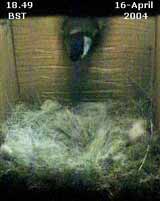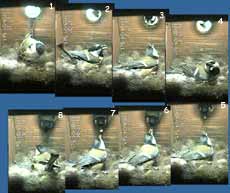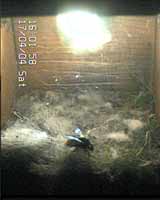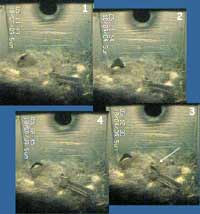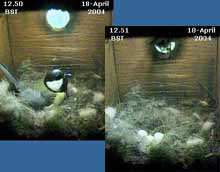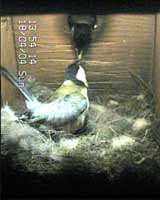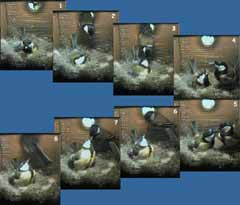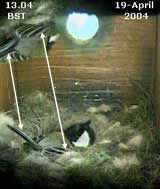|
Egg Laying (Part 2) - April 2004 |
Go to last entry on this page.............................Previous entry16 April - Egg #5? Another early delivery, with, as far as I can tell an egg being laid at about 5.16am.
Then, all of a sudden it was all over, the bobbing stopped and she tucked her head back under her wing for the next minute (pic 6). During the whole process she made no sound at all - in contrast to the dawn chorus outside, with a Blackbird singing very close by. Then she spent time fussing over the nest and having more pauses to rest, although not in the nest cup now. At 5.36 she took a first look out and after some more rest periods she fluttered her wings, jumped up to the exit and was gone.
The usual occasional daytime visits ended when she entered the box at 6.49pm and almost immediately settled down. She remained in the box since then.
Interestingly, she has been calling, with quiet series of chirps during the first ¾hour she has been in. including once when her head was down in the nest as shown here. I didn't hear any sign of a response from outside.
17 April - This morning she left me wondering - did she lay on egg or not? I've looked at the recordings a number of times (starting from 4am) and there were two periods (5.25am and 5.34am) when it looked as though she was getting into position to lay but we didn't see the usual heavy breathing etc. The only thing I can be certain of is that she left the box at 5.41am! I have not been keeping careful track of things during the day, but I did see her being fed in the box, I think for the first time.
Then as he put his head in through the entrance she turned back to receive the morsel of food in his beak (pic 5). Her first attempt failed and he withdrew momentarily (pic 6). When he presented the food a second time she took it (pic 7) and as she sank back into the nest you can see a thread of mucus (?) between them. He left and she spent a short time arranging nesting materials before departing.
It wandered about for a short time, spent a few seconds buzzing against the glass and then walked back to the exit and left (a sigh of relief at this point!) As you may just make out, it is one of the Red-tailed bumblebees. The Great Tit was back in the box for the night by 6.22pm, and settled down very quickly indeed. 18 April - Egg #7? This morning our Great Tit woke to the sound of rain, which drowned out any dawn chorus that may have been performed. She showed the first signs of waking at around 5am.
By 5.09am I noticed her tail dropping slightly as she lifted her head (pic 2). Then there was a rapid, but only slight raising of her rear end (pic 3 - On the image I have included an arrow to point out the raised wingtip) and the further drooping of her tail. There were about 30 seconds of what looked like strained movement of wing tip and tail before she relaxed again (pic 4).
Afterwards, she kept still for about half a minute before she started to move about, look down into the nest cup and start pulling nesting towards it. Then it was a case of periods of activity alternating with rest stops until around 5.50am when she became more alert. A wing stretch at 6.04am was followed by a look out into the wet dawn, then another look at the eggs was followed by a few moments covering them, before she headed out of the box at 6.06am, accompanied by the 'music' of a calling Rook. Up to 9.25am she has not reappeared. She did make a brief visit at 10.38am and then appeared again just after 11am. At this point the video tape came to an end. I had gone out for just over an hour and forget to put in a blank tape.
As the eggs were left largely uncovered I dashed down to the box and checked with my dental mirror (without opening the glass). There were six eggs visible. She was back in at just after 1pm for another 20 minute stay. Since then she has been out of the box three times for just a total of 14 minutes - it seems as though the transition to incubation has begun.
Just to reinforce that idea, she started calling quietly ( with head down in the nest) at around 1.53pm and the male turned up to feed her just a minute later. She left the box at about 2.18pm and was away about ten minutes. Her next two trips out were for around ½hr and then 1½hr, returning at 5.12pm. This time she settled down into the nest cup and put her head down for some time, until we heard her muffled uttering of several bursts of chirps. Click on images to see larger versions
He stretched down and their beaks met (pic 3) before he jumped down onto the nest beside her (pic 4). A morsel of food was passed to her (pic 5) and he immediately hopped back up to the entrance (pic 6). However, before leaving he once again reached down and their beaks met briefly, but gently (pic 7) before he headed out (pic 8).
I suppose the experts will probably say that the female was simply trying to get food, but those moments as he arrived and departed must be as close as it can get to a kiss in the bird world! She stayed in the nest until she had another trip out in the pouring rain at just after 6pm. She was back in by 6.13pm and as I write this twenty minutes later she is all fluffed up, with her head hidden and breathing at about 85 breaths/minute which is marginally faster that the 80b/m that I counted at around 4.30am this morning (via video). It's interesting that while she is snuggled down the Blue Tits are still active in the garden. 19 April - Another egg laid ( Egg #8?) There was hardly a move from our female before 5am but she became more restless by 5.05am.
She gradually turned her head (pics, 2 & 3) and then the rear end of her body suddenly raised up (pic 4), at the moment I assume the egg was laid. It stayed that way for over a minute (pic 5) before she relaxed again (pic 6). After that it was the usual case of alternating rest and nest adjusting before she left the box at 5.56am. She has spent quite a bit of time sitting on the eggs this sunny morning, and I hope to add some detail later on how much time she has spent away from the nest.
In the meantime, I have rigged up a piece of front mirrored glass so that we can see the eggs when she is not sitting on them. As I look at it at 11.30am I can see seven eggs clearly, and there is an eighth one which is hidden from the camera. You can see the reddish-brown speckled pattern on a white backround. Each egg measures about 18x14 mm.
In this image I have indicated the reflections of the bird's tail and right wing so that you can see how the reflection reverses the image so that it appears almost upside-down. Hopefully it won't look too strange when the female is sitting, and I hope it will allow us to see the hatching when it occurs in nearly two weeks. I recorded the activities in the box so that I could come up with a few figures for the first day of incubation. Between the time she left for the first time at 5.56am and returned for the night at 6.58pm (782 minutes) she spent some 610minutes (78%) in 25 sessions of sitting on the eggs, leaving the box 26 times for an average time of about 6½minutes. She put her head head down into the nest cup, presumably to turn the eggs some 87 times, which means that she did it at intervals of about 7 minutes. The male brought food for his partner for the first time at 6.49am and then at 7.35am, 10,26am and 3.36pm, although he didn't enter the box, feeding his partner from the entrance. I listened very closely during a couple of these moments but I couldn't make out the male calling. However, the first sign of his arrival were the bursts of quiet chirping by the female (usually three bursts). When the male arrived at the entrance she would stretch up her head, beak wide open and making a sort of faint, somewhat hoarse crying/wailing sound (probably not a good description) as she begged for the food. This morning the female was in the box when the lamps switched on at around 6.45am, before sunlight had started entering the box. This was the first time for her to be present at this moment and she was obviously startled by the change. She left the box, returning after about five minutes. I have reset the timer so that they come on at 7am again, after the first sunbeams light up the box. |
|

